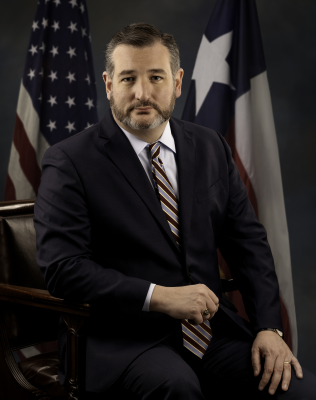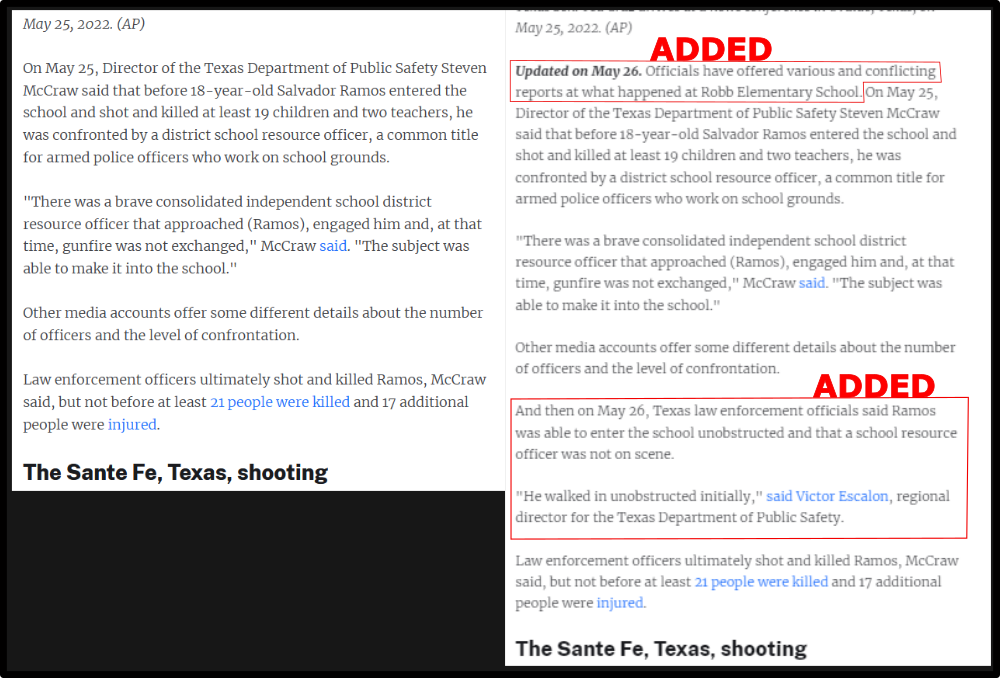For years, we have scratched our heads over PolitiFact’s spotty compliance with its own policies. Zebra Fact Check has built a collection of correction requests where PolitiFact has either ignored the request or made a correction without following its policy on corrections. A PolitiFact Fact Check from May 26, 2022 introduces another stellar example of the fact checkers’ clay feet.

PolitiFact’s fact-check attempted to examine a claim from Sen. Ted Cruz (R-Texas) in the wake of a tragic school shooting in Uvalde, Texas. Cruz said past experience shows us “the most effective tool for keeping kids safe is armed law enforcement on the campus.”
When Zebra Fact Check first noticed the fact check, PolitiFact had already inserted a note in the midst of the text saying, in bold italics, “Updated on May 26.” Updated how? That was a mystery. Nobody had archived the original version of the page using the Internet Archive’s Wayback Machine. Fortunately, we were able to access and archive a Google Cache version of the page predating PolitiFact’s “update.”
Was This an Update or Something Else?
We found PolitiFact had added new material and altered its original version of the fact check.
Is that an “update”?
Let’s review PolitiFact’s description of its update policy. Text near the top of its page of principles reads “Last updated April 18, 2022“:
Updates – From time to time, we add additional information to stories and fact-checks after they’ve published, not as a correction but as a service to readers. Examples include a response from the speaker we received after publication (that did not change the conclusion of the report), or breaking news after publication that is relevant to the check. Updates can be made parenthetically within the text with a date, or at the end of the report. Updated fact-checks receive a tag of “Corrections and updates.”
Of course we have yet to discuss the specific changes PolitiFact made from its fact check. But plainly PolitiFact did not treat this “update” the way it says it treats updates. PolitiFact’s policy says “Updates can be made parenthetically within the text with a date.” Parenthetically means using parentheses. PolitiFact added no parentheses to aid the reader in identifying added or changed material. Nor did PolitiFact separate the updated material from the original text by placing it at the end.
Instead, PolitiFact skirted the purpose of its policy to leave it unclear to readers how it changed its fact check. In reality, PolitiFact made changes to its story in addition to adding new material. Edits of that type typically qualify as “corrections.”
What Does the Uvalde Case Prove?
If armed officers were not present at the Uvalde school when the shooter entered, then PolitiFact’s would-be contradiction of Cruz does not work. Uvalde has no real place in the story except as background helping explain why Cruz was addressing the topic.
Yet PolitiFact’s updated story kept Uvalde in a starring role. New information placed in doubt the idea that armed police were at the school when the shooter arrived. But PolitiFact still touched on Uvalde first, as though that case undercuts Cruz.
This comes from the updated version of the story:
Is it true that we know from “past experiences that the most effective tool for keeping kids safe is armed law enforcement on the campus”?
No.
Whether it’s anecdotal evidence or broad-based research, there is little to support Cruz’s claim. Let’s start with what happened in Uvalde, Texas.
Again, without armed police on hand to discourage the shooter’s entry to the school, the Uvalde case serves as no kind of test for Cruz’s claim. Uvalde does not belong in the fact check as a refutation of Cruz without armed guards present.
What did PolitiFact add?
PolitiFact added a new sentence and two paragraphs to a section of its fact check describing the Uvalde shooting.
Zebra Fact Check created an image showing red boxes around the added material.

Update as Stealth Correction
In addition to keeping Uvalde as its spotlighted example contradicting Sen. Cruz, PolitiFact changed existing text.
In the original version, PolitiFact led off its section on Uvalde with the subheader “Uvalde shooter confronted by school officer.”
In the supposedly updated version, PolitiFact changed the subheader to “Uvalde shooting details.”
That change does not qualify as an update as defined in PolitiFact’s statement of principles. It does qualify as a stealth edit.
Zebra Fact Check reached out to PolitiFact on May 27, 2022 asking it to follow its policy on corrections and updates. We will update this item should we notice PolitiFact has responded to our request.
Pre-publication update, May 30,2020
On May 29, 2020 we noticed PolitiFact had updated its fact check again. The update happened at some point after we sent our correction. What changed this time?
PolitiFact removed the update notice from the section on the Uvalde shooting and inserted a new update notice at the end of the fact check:
This story was updated on May 26 at 3:30 p.m. ET to include new information from Texas law enforcement officials.
Problems with PolitiFact’s Attempted Fix
Where do we begin?
Most glaringly, PolitiFact’s “update” fails to own up to the alterations and deletions from the original published version. The Internet Archive somehow added the first version to its collection, and we were able to find more changes using its comparison tool. PolitiFact omitted one bullet point and both changed and reordered another.

Those changes certainly do not count as updates as PolitiFact’s statement of principles defines them.
Another Biased Interpretation
Mainstream fact checkers tend to struggle with biased interpretations. Bias may easily lead us to interpret statements in ways that agree with our own thinking. Fact checkers must work at charitable interpretation. Put simply, that means making the best sense of a text. We did that with PolitiFact’s update policy, viewing it as clear and transparent for the audience.
Those responsible for PolitiFact’s update found a different way to interpret the policy.
Instead of keeping added material set aside for easy identification by the reader, this interpretation allowed PolitiFact to insert the date of the update in one of two places while adding new material anywhere at will. And PolitiFact maintained the option of deleting or rewriting material as well, without resorting to messy things like corrections or clarifications.
Who needs corrections and clarifications when “update” covers everything?
Yet PolitiFact’s statement of principles keeps a place for corrections and clarifications. As it should. If only PolitiFact’s staff could make good sense of its policies.
What Do We Call an Update to an Update?
Finally, PolitiFact’s attempted fix of its update counts as a correction in its own right. But PolitiFact posted no correction notice.
What needs to happen so that PolitiFact will scrupulously follow its own policies?


